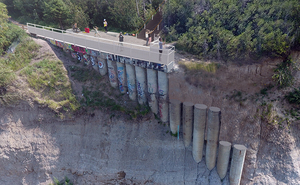
Keillor Point Lookout/The End of the World, amiskwaciy wâskahikan
Leslie Sharpe
Latitude: +53.5114°
Longitude: +113.5408°
Leslie Sharpe will be streaming from trails at Keillor Point, aka ‘The End of the World,’ located on Treaty 6 territory in Edmonton – Amiskwaciy Wâskahikan. Listen for local and migratory birds, urban wildlife, awakening bodies of people hiking or living in the river valley, the odd screaming muffler, and possibly a few roars of zoo animals as they wake across the river.
Say it: Amiskwaciy Wâskahikan, knowing it is also the sound of a place.
A day ago hundreds of sandhill cranes flew overhead, bellowing their distinctive sounds as they passed over the North Saskatchewan river. Along with snow geese and numerous other bird species, they fly over and stop in this area as they migrate north to the Canadian Arctic and SubArctic. With any luck we may hear some of them cross the North Saskatchewan River, their sounds mixing with numerous local bird species.
Keillor Point, aka ‘The End of the World,’ is the site of an old road that fell off the cliff, leaving concrete pilings that became popular as a subcultural hang-out with spectacular views of the river valley. Mixing concerns about safety and increasing party-life with the growing rise in real-estate value of the nearby neighbourhoods, the city built a stable viewing platform and formal stairs and trails to replace ‘secret’ paths and the perilous hidden lookout point.
I'll be moving within this area to follow the sounds.
A day ago hundreds of sandhill cranes flew overhead, bellowing their distinctive sounds as they passed over the North Saskatchewan river. Along with snow geese and numerous other bird species, they fly over and stop in this area as they migrate north to the Canadian Arctic and SubArctic. With any luck we may hear some of them cross the North Saskatchewan River, their sounds mixing with numerous local bird species.
Keillor Point, aka ‘The End of the World,’ is the site of an old road that fell off the cliff, leaving concrete pilings that became popular as a subcultural hang-out with spectacular views of the river valley. Mixing concerns about safety and increasing party-life with the growing rise in real-estate value of the nearby neighbourhoods, the city built a stable viewing platform and formal stairs and trails to replace ‘secret’ paths and the perilous hidden lookout point.
I'll be moving within this area to follow the sounds.
The End of the World/Keillor Point overlooks The North Saskatchewan river, whose name is derived from the Cree word kisiskâciwanisîpiy (swift-flowing river), and is located on Treaty 6 territory in Edmonton – Amiskwaciy Wâskahikan (in Cree, Beaver Hills House) – the traditional meeting ground for the Cree, Saulteaux, Nakota Sioux, Blackfoot, Métis, and many other Indigenous peoples, with evidence of their presence here from over 10,000 years. This area was a crossroads for meeting, for fishing and hunting, and foraging plants, berries and roots. The river was formative in European and British colonization of western Canada through the fur trade, displacing and damaging indigenous life and culture as colonization spread disease, hindered indigenous ways of life, annihilated animal species, and usurped lands.
As you listen, imagine a life that has been here long before colonization, the birds passing over have also migrated past here for thousands of years, their timeframes and species encounters now changed by climate change. Look up how to pronounce Amiskwaciy Wâskahikan, and listen as you say it, knowing it is also the sound of a place.